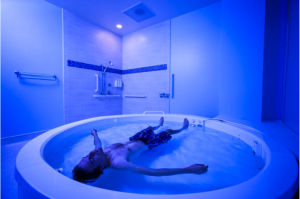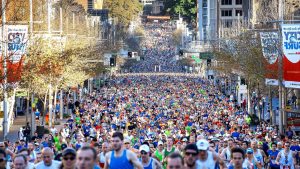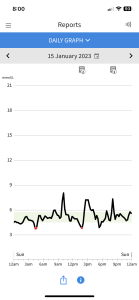-
Should You Exercise When You're Sick?
Here Are the Rules!

As a (dumb) male with an A-type personality, it took me about 15 years to truly understand the importance of respecting my body when I'm sick. I can't count how many times I continued to train, often intensely, while I was unwell, which ended up delaying my recovery by an additional 2 to 3 weeks. Yep, dumb!
Ok, here's my rules, now!
Anything below the nose requires complete rest—no activity at all, and I need more sleep. Furthermore, I cannot return to training until my chest is clear. This is non-negotiable.
For symptoms above the nose, I should reduce my training intensity by 50%, meaning it should feel very easy while I keep an eye on my temperature.
I will only resume normal training once my training heart & breath rate and my resting heart rate return to normal levels for me.
-
Ya gotta try a Salted Float Tank!

My wife was a full-time athlete at the Australian Institute of Sport (AIS) in Canberra during the 1990s. One of the added bonuses of my regular visits at that time was that she would book a float tank session for me.
A salt float tank, also known as a sensory deprivation tank or flotation tank, is a lightproof and soundproof tank filled with highly concentrated Epsom salt water, heated to skin temperature. This creates a buoyant environment in which individuals can float effortlessly, minimizing sensory input and promoting deep relaxation. The experience is designed to reduce external stimuli like light, sound, and touch, allowing the mind and body to achieve a state of deep relaxation and potentially experience various therapeutic benefits.
My sessions lasted 30 minutes, and with zero thought of drowning , I would inevitably fall asleep.
The pure weightlessness removed all pressure from my joints and muscles, which felt amazing.
🏋️♀️ While the athletes believed it promoted improved functional recovery and
even boosted injury repair, my main takeaway was the brain-de-stressing advantage🧠
These days, there are commercial centres everywhere, and for around $50, you can enjoy 30 minutes of total bliss.
-
Why the City to Surf is awesome!
And how you should tackle it!

The City to Surf is an event, not a running race!
Unless you have a priority start near the front of the starting line, it's unlikely you'll achieve a personal best among 100,000 participants.
If you do have a spot near the front, make sure to warm up as best you can. Safely roll down William Street, press on to the Coke sign, and then run smart tangents while embracing the hurt all the way to Bondi.
👟 Good luck!
For those of you who are first-timers, please relax—this event is designed for you!
It's completely normal to feel a bit nervous the day before and the morning of the event. But believe me, once you get started, all those nerves and apprehensions will disappear!

You’ll see plenty of people in monkey suits, and you might even get a hug from Wonder Woman.
Be sure to enjoy the 20+ bands along the way, and feel free to sing along to "Sweet Caroline."
Remember, for every uphill section, there’s a downhill. So take your time on the ascents.
You will likely cover close to 15 kilometres, as you won't be following the "smart tangents." Just go with the flow!
With 40% of the 100,000 participants walking, you're bound to strike up a friendly conversation with other smiling entrants.
Finishing the event is always an incredible feeling, and you’ll be proud of your achievements. My favourite part is the post-race gathering with others, usually over a beer. Everyone completes the same course on the same day!
When in doubt, smile!
-
Margaret, 51, recommends this type of exercise!
When I met Margaret, who is 51 years old, she openly discussed her health status with me. She mentioned feeling intermittently tired, craving sweeter snacks, experiencing a higher-than-normal body temperature, and feeling bloated. Aside from one glass of wine in the evenings, she felt her diet was pretty good. Additionally, she noted that she seems to be waking up more randomly than ever before.
I emphasised that these symptoms and feelings are normal, frustrating, but also quite common during this time. Since Margaret's skeletal muscle mass and overall health are within a healthy range, I recommended that we focus primarily on resistance exercise rather than making wholesale changes to her diet, sleep patterns, and cardiovascular activity. My experience, along with available research, confirms the extraordinary benefits of safe, structured resistance exercise for women during their adaptation years.
Here are some benefits that Margaret and her assessment data confirm from 12 weeks of resistance training.
💪 Stronger and more toned muscles:
Muscle mass naturally declines with age, leading to decreased strength and mobility. Resistance training helps counteract this loss, maintaining functional abilities and independence.
🦴 Increased bone density:
Weight-bearing exercises, such as resistance training, stimulate bone growth, reducing the risk of osteoporosis and fractures, which are common concerns for women over 50.
🔋 A boost in metabolic energy:
Strength training boosts metabolism, helping women manage their weight more effectively by increasing muscle mass, which burns more calories at rest.
🤸♂️ A return of balance & coordination:
Improved balance and coordination through resistance training reduces the risk of falls, a significant concern for older adults.
☺️ A more positive emotional outlook:
Exercise, including resistance training, releases endorphins, which have mood-boosting effects.
😴 Sleeping more soundly:
Regular exercise can improve sleep quality and reduce insomnia.
Margaret's starting skeletal (bone) mass was 10.4kg, while now she's assessed at 10.7kg - this is good. I will avoid before and after photos, as they can seem a bit tacky. Yes, Margaret has changed her shape and clothing size.
Gyms, trainers (particularly, male), designer active wear, and subscription apps can all be deterrents for starting safe resistance exercise. Margaret simply follows the monthly resistance set list at home - click below. In my next post, I'll throw up Margaret's full nutrition plan.
-
Curbing the increasing Aussie Male Appetite!
I've just completed a Men's Health case study with 50 blokes (most 45+)!
The purpose of the project was to change (lower or suppress) the male appetite!

Why?
Recent data indicates that Australian males are consuming significantly more calories than necessary. This trend has been on the rise since around 1990. One likely cause is the increased availability of affordable, heavily promoted food options. As a result, it seems that the natural appetite of men has shifted, altering their perception of how many calories are required for survival. We don't seem to see the same trend with woman.
The starting assessment data shows that nearly all men who likely eat too much confirmed the following;
🩸 Higher average blood glucose
💧 Dehydrated
🥦 Low dietary fibre (and gut-biome imbalance)
🕰️ Irregular eating habits
🏋️ Either; not moving enough OR moving too hard for their aging bodies

The complete 14-day project is linked below. In summary, utilising a 14-day continuous glucose monitor (CGM) is a game-changer. The real-time glucose feedback allowed the participants to see exactly how their bodies reacted to additional carbohydrate calories.
To make the process engaging, we encouraged them to stay within the "sweet green zone." We emphasised the importance of staying properly hydrated, made vegetables more appealing by adding spices and healthy fats, monitored the intensity of their activities, and maintained a consistent structure in these lifestyle strategies. The combination of these strategies naturally suppressed the appetite – as in – it reset food behaviour.
Let me know if you'd like a crack!
........................................................................................................................................................................

